1993 BUICK PARK AVENUE night vision
[x] Cancel search: night visionPage 183 of 340
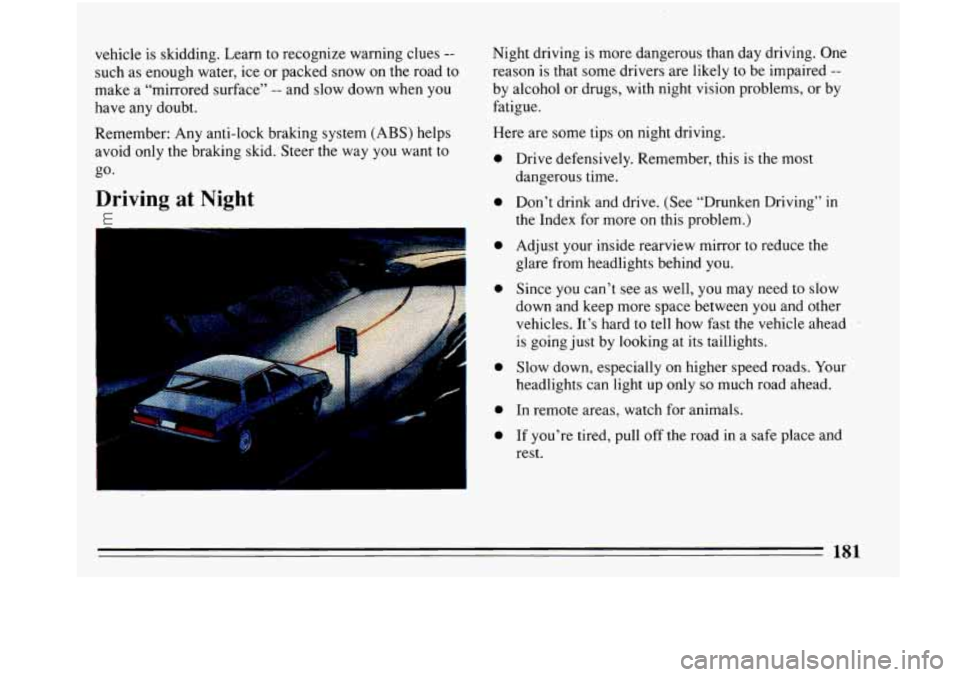
vehicle is skidding. Learn to recognize warning clues --
such as enough water, ice or packed snow on the road to
make a “mirrored surface”
-- and slow down when you
have any doubt.
Remember: Any anti-lock braking system (ABS) helps
avoid only the braking skid. Steer the way
you want to
go-
Driving at Night
...,.
.. -
Night driving is more dangerous than day driving. One
reason
is that some drivers are likely to be impaired --
by alcohol or drugs, with night vision problems, or by
fatigue.
Here are some tips on night driving.
0
0
0
c
0
0
0
Drive defensively. Remember, this is the most
dangerous time.
Don’t drink and drive. (See “Drunken Driving” in
the Index for more on this problem.)
Adjust your inside rearview mirror to reduce the
glare from headlights behind you.
Since you can’t see as well, you may need to slow
down and keep more space between you and other
vehicles. It’s hard
to tell how fast the vehicle ahead .
is going just by looking at its taillights.
Slow down, especially on higher speed roads. Your
headlights can light up only
so much road ahead.
In remote areas, watch for animals.
If you’re tired, pull off the road in a safe place and
rest.
ProCarManuals.com
Page 184 of 340
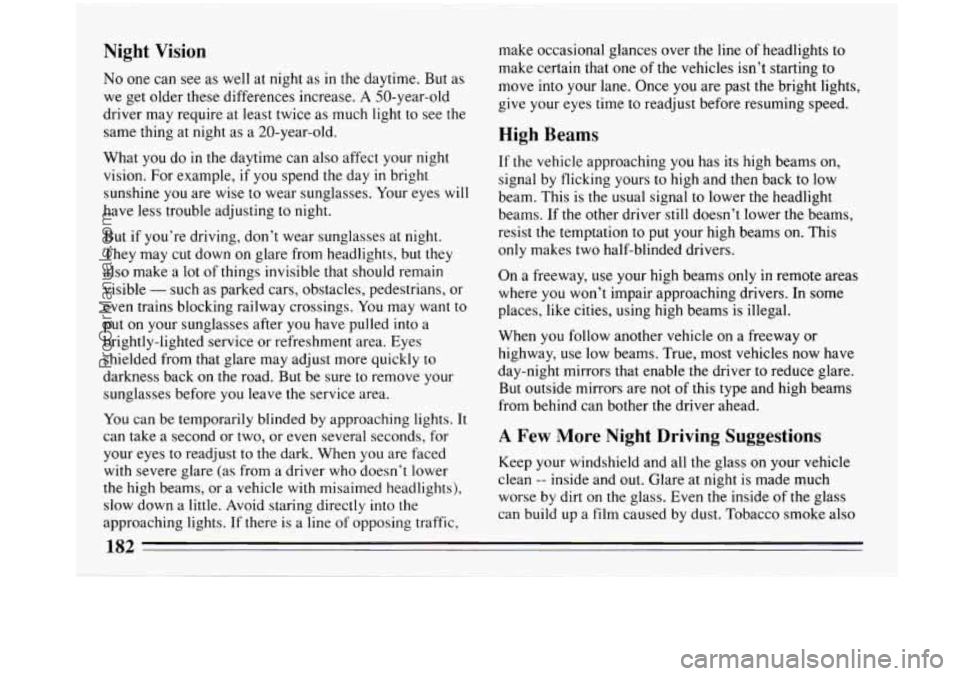
Night Vision
No one can see as well at night as in the daytime. But as
we get older these differences increase. A 50-year-old
driver may require at least twice as much light to see the
same thing at night as a 20-year-old.
What you do in the daytime can also affect your night
vision. For example,
if you spend the day in bright
sunshine
you are wise to wear sunglasses. Your eyes will
have less trouble adjusting to night.
But if you’re driving, don’t wear sunglasses at night.
They may cut down
on glare from headlights, but they
also make a lot of things invisible that should remain
visible
- such as parked cars, obstacles, pedestrians, or
even trains blocking railway crossings. You may want to
put on your sunglasses after you have pulled into a
brightly-lighted service
or refreshment area. Eyes
shielded from that glare may adjust more quickly to
darkness back
on the road. But be sure to remove your
sunglasses before you leave the service area.
You can be temporarily blinded by approaching lights. It
can take
a second or two, or even several seconds, for
your eyes to readjust
to the dark. When you are faced
with severe glare (as from a driver who doesn’t lower
the high beams, or a vehicle with misaimed headlights),
slow down a little. Avoid staring directly into the
approaching lights. If there is a line of opposing traffic, make occasional glances over
the line of headlights to
make certain that one
of the vehicles isn’t starting to
move into your lane. Once
you are past the bright lights,
give your eyes time to readjust before resuming speed.
High Beams
If the vehicle approaching you has its high beams on,
signal by flicking yours to high and then back to low
beam. This is the usual signal to lower the headlight
beams. If the other driver still doesn’t lower the beams,
resist the temptation to put your high beams
on. This
only makes two half-blinded drivers.
On a freeway, use your high beams
only in remote areas
where you won’t impair approaching drivers. In some
places, like cities, using high beams is illegal.
When you follow another vehicle on a freeway or
highway, use low beams. True, most vehicles now have
day-night mirrors that enable the driver to reduce glare.
But outside mirrors are not of this type and high beams
from behind can bother the driver ahead.
A Few More Night Driving Suggestions
Keep your windshield and all the glass on your vehicle
clean
-- inside and out. Glare at night is made much
worse by dirt on the glass. Even the inside of the glass
can build up a film caused by dust. Tobacco smoke also
ProCarManuals.com
Page 185 of 340
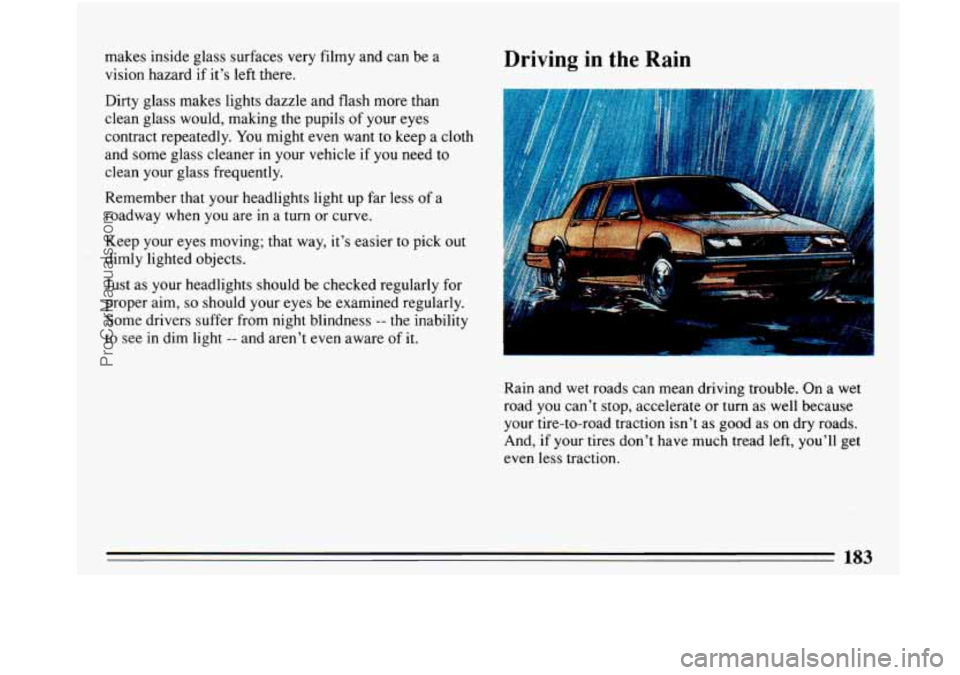
makes inside glass surfaces very filmy and can be a
vision hazard if it’s left there.
Dirty glass makes lights dazzle and
flash more than
clean glass would, making the pupils of your eyes
contract repeatedly. You might even want to keep a cloth
and some glass cleaner in your vehicle if you need to
clean your glass frequently.
Remember that your headlights light up far less of
a
roadway when you are in a turn or curve.
Driving in the Rain
Keep your eyes moving; that way, it’s easier to pick out
dimly lighted objects.
Just as your headlights should be checked regularly for
proper aim,
so should your eyes be examined regularly.
Some drivers suffer from night blindness
-- the inability
to see in dim light
-- and aren’t even aware of it.
Rain and wet roads can mean driving trouble. On a wet
road you can’t stop, accelerate or turn as well because
your tire-to-road traction isn’t as good as on dry roads.
And, if your tires don’t have much tread left, you’ll get
even less traction.
ProCarManuals.com
Page 194 of 340
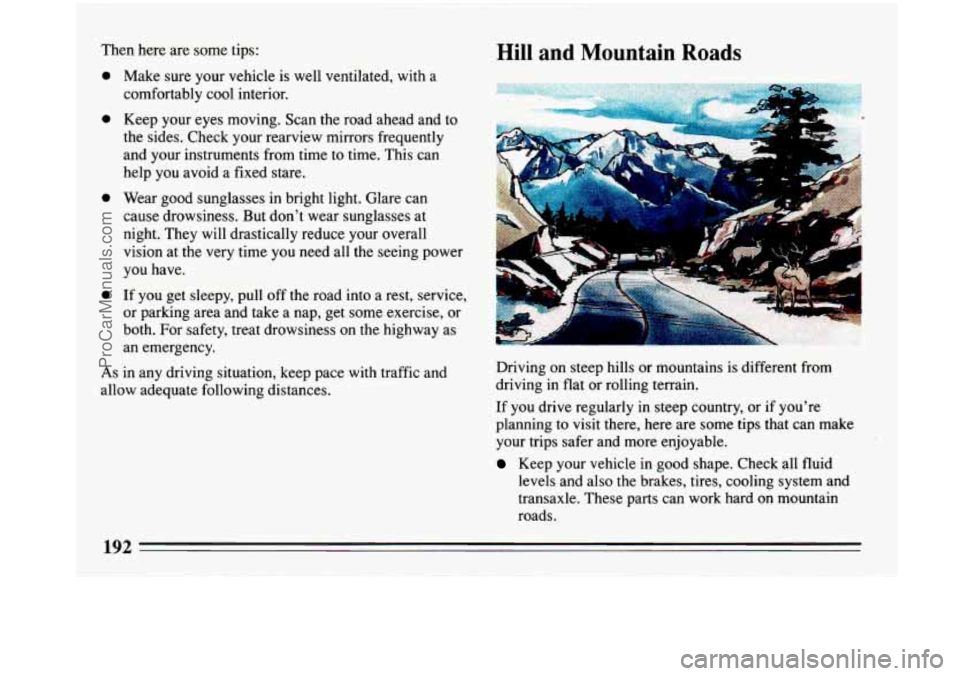
Then here are some tips:
e
e
e
e Make sure your vehicle is well ventilated, with a
comfortably cool interior.
Keep your eyes moving. Scan the road ahead and to
the sides. Check your rearview mirrors frequently
and your instruments from time
to time. This can
help you avoid
a fixed stare.
Wear
good sunglasses in bright light. Glare can
cause drowsiness. But don't wear sunglasses at
night. They will drastically reduce your overall
vision at the very time you need all the seeing power
you have.
If you get sleepy, pull off the road into a rest, service,
or parking area and take a nap, get some exercise, or
both. For safety, treat drowsiness
on the highway as
an emergency.
As in any driving situation, keep pace with traffic and
allow adequate following distances. Driving on
steep hills or mountains is different from
driving in flat or rolling terrain.
If you drive regularly
in steep country, or if you're
,planning to visit there, here are some tips that can make
your trips safer and more enjoyable.
Keep your vehicle in good shape. Check all fluid
levels and also the brakes, tires, cooling system and
transaxle. These parts can work hard
on mountain
roads.
192
ProCarManuals.com
Page 329 of 340
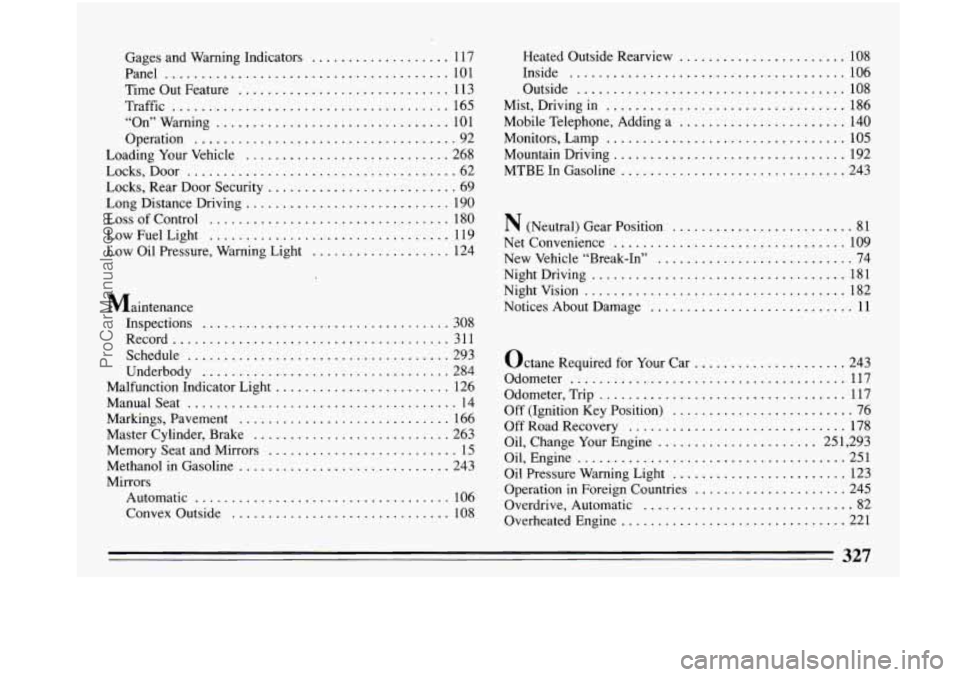
Gages and Warning Indicators ................... 117
Panel
....................................... 101
Time Out Feature
............................. 113
Traffic
...................................... 165
“On” Warning
................................ 101
Operation
.................................... 92
Loading Your Vehicle
............................ 268
Locks. Door
..................................... 62
Locks. Rear Door Security
.......................... 69
Long Distance Driving
............................ 190
Loss of Control
................................. 180
Low Oil Pressure. Warning Light
................... 124
LowFuelLight
................................. 119
Maintenance
Inspections
.................................. 308
Record
...................................... 311
Schedule
.................................... 293
Underbody
.................................. 284
Malfunction Indicator Light
........................ 126
Manualseat
..................................... 14
Markings, Pavement
............................. 166
Master Cylinder, Brake
........................... 263
Memory Seat and Mirrors
.......................... 15
Methanol in Gasoline ............................. 243
Mirrors Automatic
................................... 106
Convex Outside
.............................. 108 Heated
Outside Rearview
....................... 108
Inside
...................................... 106
Outside
..................................... 108
Mist, Driving in
................................. 186
Mobile Telephone, Adding a
....................... 140
Monitors, Lamp
................................. 105
Mountain Driving
................................ 192
MTBE In Gasoline
............................... 243
N (Neutral) Gear Position ......................... 81
Netconvenience
................................ 109
New Vehicle “Break-In”
........................... 74
NightDriving
................................... 181
Nightvision
.................................... 182
Notices About Damage
............................ 11
Octane Required for Your Car
..................... 243
Odometer
...................................... 117
Odometer. Trip
.................................. 117
Off (Ignition Key Position)
......................... 76
Off Road Recovery .............................. 178
Oil. Change Your Engine
...................... 25 1. 293
Oil. Engine
..................................... 251
Oil Pressure Warning Light
........................ 123
Operation in Foreign Countries
..................... 245
Overdrive. Automatic ............................. 82
Overheated Engine
............................... 221
327
ProCarManuals.com